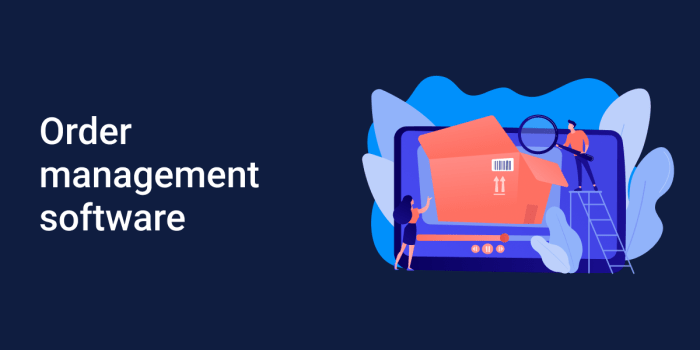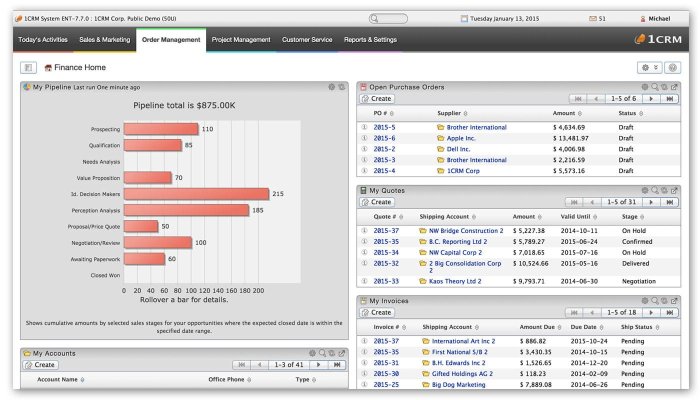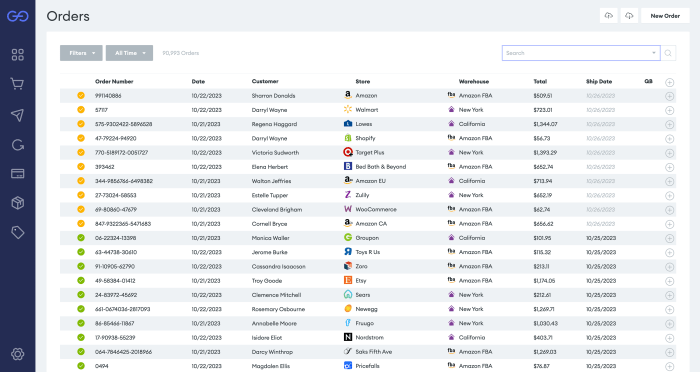Crm and order management software – In today’s dynamic business landscape, efficient management of customer relationships and orders is paramount for success. Integrating Customer Relationship Management (CRM) and Order Management Software (OMS) systems offers a powerful synergy, streamlining operations and boosting profitability. This comprehensive guide delves into the intricacies of both, exploring their individual functionalities, the benefits of integration, and how businesses can leverage them for optimal growth.
Understanding Customer Relationship Management (CRM) Software
CRM software is a centralized system designed to manage and analyze customer interactions and data throughout the customer lifecycle. From initial contact to post-sales support, CRM platforms capture valuable insights, enabling businesses to personalize interactions, improve customer satisfaction, and ultimately drive sales. Key features include:

Source: bordio.com
Core CRM Features:
- Contact Management: Storing and organizing customer information, including contact details, purchase history, and communication logs.
- Sales Force Automation (SFA): Automating sales processes, such as lead generation, opportunity tracking, and sales forecasting.
- Marketing Automation: Automating marketing campaigns, including email marketing, social media engagement, and targeted advertising.
- Customer Service Management: Managing customer inquiries and support requests through various channels, such as email, phone, and chat.
- Reporting and Analytics: Generating reports and analyzing data to track key performance indicators (KPIs) and identify areas for improvement.
Types of CRM Software:, Crm and order management software
- Operational CRM: Focuses on automating business processes to improve efficiency and productivity.
- Analytical CRM: Focuses on analyzing customer data to gain insights and improve decision-making.
- Collaborative CRM: Focuses on improving communication and collaboration between different departments and teams.
Popular CRM platforms include Salesforce, HubSpot, Zoho CRM, and Microsoft Dynamics 365. The choice of CRM depends on the specific needs and size of the business.
Understanding Order Management Software (OMS)
Order Management Software (OMS) is a system designed to streamline the entire order fulfillment process, from order placement to delivery. An effective OMS system enhances efficiency, reduces errors, and improves customer satisfaction. Key features include:
Core OMS Features:
- Order Entry and Processing: Efficiently managing incoming orders from various channels (e.g., online store, phone, email).
- Inventory Management: Tracking inventory levels in real-time, managing stock replenishment, and preventing stockouts.
- Warehouse Management: Optimizing warehouse operations, including picking, packing, and shipping.
- Shipping and Delivery: Integrating with shipping carriers to manage shipping costs and track shipments.
- Returns Management: Streamlining the returns process and managing returned goods.
- Order Tracking and Visibility: Providing customers with real-time updates on their order status.
- Reporting and Analytics: Tracking key metrics such as order fulfillment time, shipping costs, and return rates.
Examples of OMS solutions include NetSuite, Shopify, and Oracle Order Management. Selecting the right OMS depends on factors such as order volume, complexity, and integration requirements.
The Power of CRM and OMS Integration
Integrating CRM and OMS systems creates a powerful synergy, providing a holistic view of the customer journey and enhancing operational efficiency. Key benefits include:
Benefits of Integration:
- Improved Customer Experience: Providing personalized service and timely order updates enhances customer satisfaction.
- Increased Efficiency: Automating processes and reducing manual data entry saves time and resources.
- Reduced Errors: Eliminating data silos and improving data accuracy minimizes errors and improves order accuracy.
- Better Inventory Management: Real-time inventory visibility enables proactive stock management and prevents stockouts.
- Enhanced Sales and Marketing: Insights from customer data enable targeted marketing campaigns and improved sales strategies.
- Improved Forecasting: Accurate sales forecasting based on historical data and customer trends improves planning and resource allocation.
Integration can be achieved through various methods, including API integrations, middleware solutions, and cloud-based platforms. Careful planning and selection of integration methods are crucial for a seamless and effective integration.
Choosing the Right CRM and OMS Software
Selecting the right CRM and OMS solutions requires careful consideration of several factors:
Key Considerations:
- Business Size and Needs: Choose solutions that scale with your business growth and address your specific needs.
- Budget: Consider the cost of software licenses, implementation, and ongoing maintenance.
- Integration Capabilities: Ensure seamless integration with existing systems and other third-party applications.
- Scalability and Flexibility: Choose solutions that can adapt to future business needs and changes.
- User-Friendliness: Select intuitive and easy-to-use solutions to ensure user adoption.
- Customer Support: Choose a vendor that provides reliable and responsive customer support.
Frequently Asked Questions (FAQ)
- Q: What is the difference between CRM and OMS? A: CRM focuses on managing customer relationships and data, while OMS focuses on managing the order fulfillment process.
- Q: Do I need both CRM and OMS? A: While not strictly required, integrating both systems significantly enhances efficiency and customer experience, especially for businesses with substantial order volumes.
- Q: How much does CRM and OMS software cost? A: Costs vary greatly depending on the vendor, features, and number of users. Some offer subscription-based models, while others offer one-time purchases.
- Q: How long does it take to implement CRM and OMS software? A: Implementation time depends on the complexity of the systems and the size of the business. It can range from a few weeks to several months.
- Q: What are the key benefits of integrating CRM and OMS? A: Integration improves customer experience, increases efficiency, reduces errors, and provides a holistic view of the customer journey.
Conclusion
Implementing CRM and OMS software, especially when integrated, is a strategic investment that can significantly improve a business’s operational efficiency, customer satisfaction, and overall profitability. By carefully considering the factors discussed above and choosing the right solutions, businesses can leverage the power of these systems to achieve sustainable growth and competitive advantage.
References
Call to Action: Crm And Order Management Software
Ready to transform your business operations? Contact us today for a free consultation to discuss your CRM and OMS needs and explore how we can help you achieve your business goals.
FAQ Explained
What are the key benefits of integrating CRM and order management?
Key benefits include improved customer service, reduced order processing errors, increased sales efficiency, better inventory management, and enhanced data-driven decision-making.
How much does CRM and order management software typically cost?
Pricing varies widely depending on the features, scalability, and vendor. Expect costs to range from affordable cloud-based solutions to more expensive enterprise-level systems.
What are some common features of integrated CRM and order management systems?
Common features include customer relationship management, order tracking, inventory management, sales forecasting, reporting and analytics, and integration with other business systems.

Source: 1crm.com
How long does it take to implement CRM and order management software?
Implementation timelines vary depending on the complexity of the system and the size of the business. Smaller businesses may see implementation within weeks, while larger enterprises may require several months.

Source: goflow.com
What types of businesses benefit most from this type of software?
Businesses of all sizes can benefit, but those with complex order fulfillment processes, large customer bases, or a need for robust data analysis will see the most significant advantages.
